
MINISTRY OF EDUCATION VIETNAM ACADEMY OF
AND TRAINING SCIENCE AND TECHNOLOGY
GRADUATE UNIVERSITY OF SCIENCE AND TECHNOLGY
-----------------------------
VU THI HIEN
REGENERATION AND MICROPROPAGATION
OF Panax vietnamensis Ha et Grushv.
USING THIN CELL LAYER TECHNOLOGY
Major: Plant Physiology
Code: 9.42.01.12
SUMMARY OF PHILOSOPHY DOCTORAL DISSERTATION
ON BIOLOGY
Ho Chi Minh City - 2018

The work was realized in Graduate University of Science and
Technology, Vietnam Academy of Science and Technology
Advisor 1: Prof. Duong Tan Nhut, Ph.D.
Advisor 2: Thai Xuan Du, Ph.D.
Reviewer 1: ...................................................................................
Reviewer 2: ...................................................................................
Reviewer 3: ...................................................................................
The thesis will be evaluated by doctoral committee at Graduate
University of Science and Technology, Vietnam Academy of
Science and Technology on ………..2018
The thesis is available at:
- Library of Graduate University of Science and Technology
- National Library of Vietnam

1
INTRODUCTION
1. The necessity of the dissertation
Ngoc Linh ginseng is a Vietnamese endemic ginseng with the
scientific name Panax vietnamensis Ha et Grushv. Since discovered in
1973, it can be said that Ngoc Linh ginseng is one of the most important
medicinal plants. Many reports indicated that Ngoc Linh ginseng has not
only the pharmacological characteristics of a Ginseng, but also the
individual characteristics such as anti-stress, decrease of depression and
anxiety, stimulation of the immune system, resistance to cytotoxic toxins,
antioxidant in vitro and in vivo, etc. The success of propagation of Ngoc
Linh ginseng is still limited because this species is only grown on Ngoc
Linh mountain. To harvest gingseng roots, the propagation period lasts 6 to
7 years to store enough bioactivities. Our thesis entitled "Regeneration and
micropropagation of Ngoc Linh ginseng (Panax vietnamensis Ha et
Grushv.) using thin cell layer technique" has been carried out. The aim of
this study is to obtain a number of vigorous plantlets with and high quality
roots and tubers, especially, they are well adapted to the natural conditions,
thereby contributing to preserving this precious medicinal plant.
2. Objective
The objective of the study was to find the explant resources, the type
and concentration of plant growth regulators (PGRs), as well as the in vitro
culture conditions suitable for different morphogenesis processes - callus
induction, direct embryogenesis, shoot and root formation, etc. The growth
and development of in vitro Ngoc Linh ginseng derived from thin cell layer
(TCL) was examined in Quang Nam to assess the adaptability of in vitro
Ngoc Linh plantlets in its natural territory, compared to those growing in
Bidoup - Nui Ba National Park, Lam Dong.
3. The contents of the thesis
3.1. Research on the morphogenesis from different explant resources
3.2. Research on growth and subsequent development of plantlets in vitro
in different ecological conditions
3.3. Qualitative and quantitative saponin in plant in vitro and at nursery.
CHAPTER I
OVERVIEW
The thesis has consulted 34 Vietnamese documents and 94 English
documents and 2 internet documents; (1) Introduction to ginseng; (2) Ngoc
Linh ginseng (Panax vietnamensis Ha et Grushv.); (3) cell culture
technology; (4) factors influencing morphogenesis; (5) plant growth
regulators; (6) the role of light in the regeneration, growth and development
of plants; (7) The plant regeneration.

2
CHAPTER II
RESEARCH OBJECTIVE AND METHODS
2.1. Materials
2.1.1. Plant materials
Explant source for morphogenesis: including leaf, petiole and rhizome
of 3-month old Ngoc Linh ginseng in vitro plants; Explants grew under
different ex vitro conditions: Ngoc Linh ginseng intact plants with rhizomes
and leaves, about 3 cm in height; explant sources for determining bioactive
agents: in vitro plantlets, 6-month old, 1-year old and 2-years old plants.
2.1.2. Equipment - tools, standard chemicals and solvents
Light intensity meter LI-250A Light meter; microscope; Equipment
used in HPLC analysis (High Performance Liquid Chromatography, Rg1,
Rb1, MR2). Chloroform: methanol: water (65:35:10).
2.2. Research Methods
2.2.1. Plant morphogenesis method
2.2.2. Plant morphology and microscope observation method
2.2.4. Saponin content analysis method
2.2.4.1. Thin layer chromatography method
2.2.4.2. High Performance Liquid Chromatography (HPLC)
2.3. Research establishment methods
2.3.1. Content 1: Researching the morphogenesis from different explant
sources
2.3.1.1. Evaluating the effect of single PGRs on morphogenesis of leaf
explant tTCL_L under light and dark conditions
2.3.1.2. Evaluating the effect of single PGRs on morphogenesis of petiole
explant tTCL_L under light and dark conditions.
2.3.1.3. Evaluating the effect of single PGRs on morphogenesis of lTCL_C
petiole explant under light and dark conditions
2.3.1.4. Evaluating the effect of single PGRs on morphogenesis of TTCL_R
rhizome explant under light and dark conditions
2.3.1.5. Evaluating the effect of the combination of auxin and cytokinin on
the morphogenesis of the leaf explant tTCL_L under light and dark
conditions.
2.3.1.6. Evaluating the effect of the combination of auxin and cytokinin on
the morphogenesis of the tTCL_C petiole explant under light and dark
conditions.
2.3.1.7. Evaluating the effect of the combination of auxin and cytokinin on
the morphogenesis of the lTCL_C petiole explant under light and dark
conditions.

3
2.3.1.8. Evaluating the effect of the combination of auxin and cytokinin on
the morphogenesis of the rhizome explant tTCL_R under light and dark
conditions.
2.3.1.9. Morphological anatomy
2.3.1.10. Develop Ngoc Linh plantlets from somatic embryos
2.3.2. Research on growth and subsequent development of in vitro
plantlets under different ecological conditions
2.3.2.1. Research on the growth and development of Ngoc Linh ginseng
cultured in vitro grown in Quang Nam
2.3.2.2. Research on the growth and development of Ngoc Linh ginseng
cultured in vitro grown in the Heaven Gate of Bidoup - Nui Ba National
Park (Lam Dong)
2.3.3. Content 3: Qualitative and quantitative saponin in ginseng in vitro
and in complete ginseng at nursery stage.
2.3.3.1. Determine the content of saponin in Ngoc Linh ginseng in vitro, 6
month ginseng, 1 year and 2 year old seedlings planted in Quang Nam.
2.3.3.2. Quantification of saponins in Ngoc Linh ginseng in vitro, 6 month
ginseng, 1 year and 2 year old trees were planted in Quang Nam.
2.4. Statistics
The experiment was completely randomized (CDR). The mean of the
follow-up indices among the treatment formulas was analyzed by ANOVA
method, then compared with the Ducan test at confidence level P <0.05
using SPSS 16.0 software. [58].
2.5. Culture conditions
2.5.1. In vitro condition
2.5.2. Ex vitro condition
2.6. Location and time of the experiment
CHAPTER III
RESULTS AND DISCUSSIONS
3.1. RESULTS
3.1.1. Research on the morphogenesis from different explant sources
3.1.1.1. Effect of single PGRs on morphogenesis of leaf explant tTCL_L
under light and dark conditions
The in vitro leaf explants of TTCL_L were inoculated in culture
medium. After 10 weeks of culture, results were observed as shown in
Table 3.1; 3.2 and 3.1; 3.2.

![Tiểu luận Cơ sở Hóa sinh: Bài luận [Mới nhất]](https://cdn.tailieu.vn/images/document/thumbnail/2025/20250710/hoangmaiphuong_t66@hus.edu.vn/135x160/622_bai-tieu-luan-co-so-hoa-sinh.jpg)

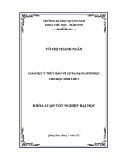

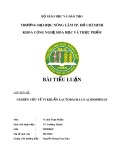
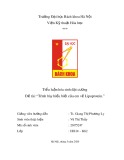
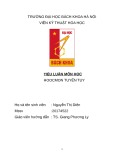
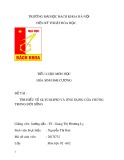
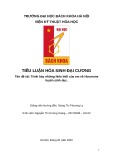


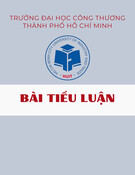
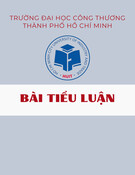
![Ô nhiễm môi trường không khí: Bài tiểu luận [Nổi bật/Chi tiết/Phân tích]](https://cdn.tailieu.vn/images/document/thumbnail/2025/20251011/kimphuong1001/135x160/76241760173495.jpg)







![Ứng dụng kỹ thuật trao đổi ion trong điện phân: Bài tiểu luận [chuẩn nhất]](https://cdn.tailieu.vn/images/document/thumbnail/2025/20250829/sonphamxuan1808/135x160/97341756442892.jpg)



